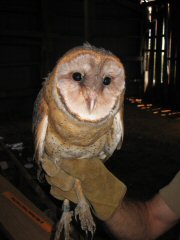

|
WILDLIFE DIVERSITY NOTEBOOK: Common Barn Owl By Kieran O'Malley
Range and Status: Barn owls are found in most of the lower 48 states with exceptions in the northern plains and New England . Barn owl populations in southern and western states are reported as stable; declines are evident however, in the Midwest and Northeast. West Virginia Status: The West Virginia Breeding Bird Atlas lists 11 barn owl records from around the state. In 2001 and 2002, DNR biologists documented seven new occurrences (including three confirmed nest sites) in Hardy and Grant counties. Unfortunately the barn owls' habits and habitat preclude an accurate assessment of their status. (See What you can do to help below) Description: The upper part of the head and wings is light brown to cinnamon color. The pale white face is disk shaped and the entire underside is white to buff. The breast is speckled with brown dots. Adult barn owls range from 12 – 16 inches in length with a wingspread of 41 – 48 inches. Males are slightly smaller than females and their breast plumage is generally lighter and not as heavily speckled. Juvenile owls resemble adults. The lack of ear tufts gives their head a rounded appearance and they are often confused with snowy owls or great horned owl fledglings. Snowy owls are pure white with black horizontal bars on their wings and chest and are rare winter visitors to West Virginia . Young great horned owls are covered with a white down but lack the large facial disk and speckled breast. Habitat: Barn owls hunt in extensive open country such as farmland, grasslands and marshes. However, they often roost undetected near houses or even towns. They historically nested in tree cavities but as land was cleared for farms and houses, they adapted to man-made structures. Today in West Virginia , most barn owls probably live in structures such as barns, silos, church steeples, or abandoned buildings. Diet: Barn owls feed primarily on small mammals such as voles, mice, and rats. They have also been known to eat birds roosting in the open such as European starlings, red-winged blackbirds, and meadowlarks. With keen eyesight and the most sensitive hearing in the bird world, Barn owls leave their roost just after sunset flying slowly over fields listening and looking for food. Life History: Barn owls are ready to breed by one year of age. They choose a single mate and search for a suitable nest site in a tree cavity, a building, or a farm structure. The female builds the nest by shredding her pellets to form a shallow cup. Pellets are small bundles of regurgitated, undigested fur and bones. Eggs are laid one to two days apart but incubation begins with the first egg. This results in asynchronous hatching and a clutch of 4 to 6 chicks of various ages. Young owls called owlets are ready to fledge about 60 days after hatching. Depending on availability of nest sites and food, barn owls can produce two and sometimes three broods a year. Some barn owls may remain near their birth site for several months while others disperse soon after fledging. Some young owls may travel as far as 1,000 miles from their birth site although most establish breeding territories within 50 miles of where they were born. This tendency to travel long distances after birth allows barn owls to find and colonize new areas. In West Virginia , barn owl breeding activity has been observed in every month of the year. Owls in the northern U.S. and Canada however, migrate south for the winter. Since these seasonal movements are largely dictated by food availability, the fact that barn owls are raising broods in the winter suggests that West Virginia has excellent barn owl habitat. Threats and Prospects: Barn owl declines in the Midwestern and Northeast states are generally attributed to the loss of foraging habitat and nesting structures. Barn owls were first affected when the land was first cleared for agriculture. The open farm land provided more foraging habitat but they lost nesting and roosting trees. They quickly adapted to the human altered landscape by moving into old- style barns, silos and other buildings. Today barn owls are again affected by changes in both foraging habitat and roosting/nesting habitat. The quality and quantity of open grassy habitat such as pastures and hayfields is decreasing as farms convert to more intensive “clean” agriculture practices or are sold off for development. These new land uses do not support the healthy rodent populations the owls require. Decreased food availability results in decreased productivity. In addition to this foraging habitat loss is the disappearance of the old-style barns and silos used for nesting. Modern silos are often sealed to prevent access and metal pole buildings often replace barns. Barn owls have proven themselves adaptable to many changes in the landscape but today their prospects for recovery depend on landowners recognizing and maintaining the basic habitat components. Wildlife agencies are working with the public to identify local owl populations and areas of important habitat. Farmland conservation programs that maintain open grassy areas help landowners provide much needed foraging habitat. Nest box programs similar to those for bluebirds and wood ducks have been shown to maintain, if not increase, reproductive success in local areas. When all the key habitat components are in place, barn owls' naturally high reproductive output and dispersal tendencies should return this beneficial species' populations to former levels.
|
 Scientific Name: Tyto alba
Scientific Name: Tyto alba